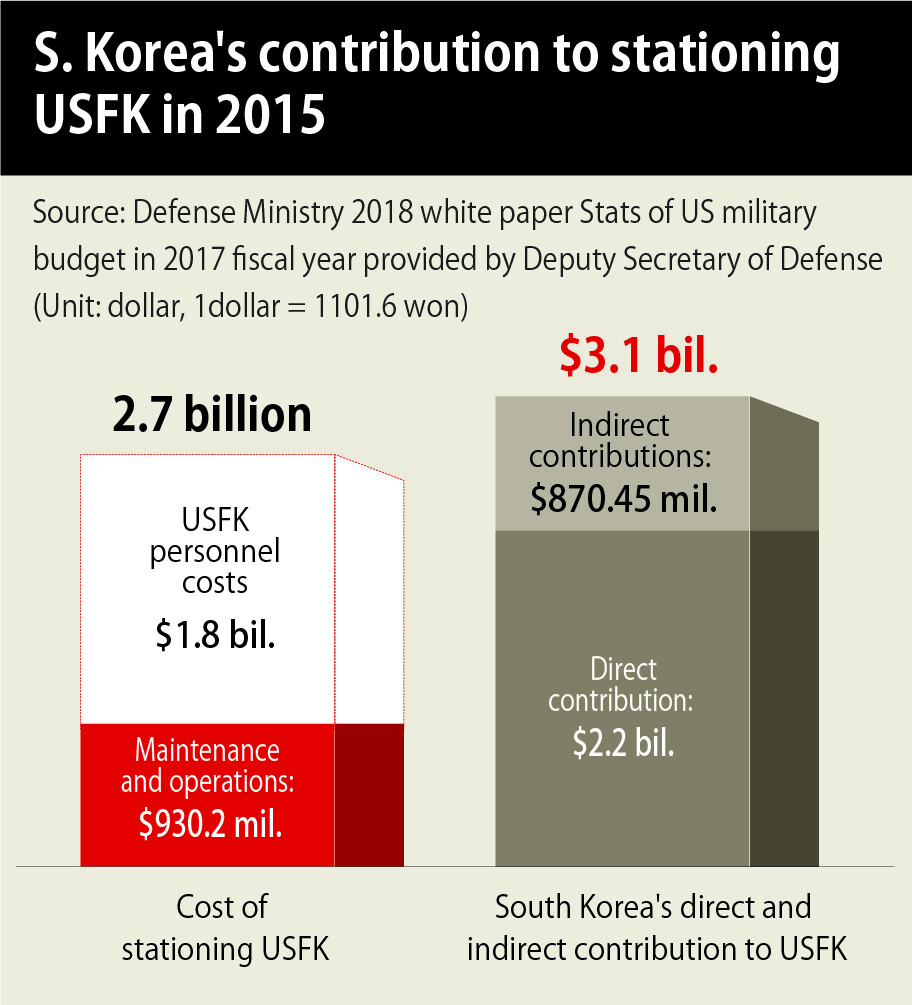hankyoreh
Links to other country sites 다른 나라 사이트 링크
[News analysis] The mysteriousness of Trump’s figures for South Korea’s defense costs

“Right now, it costs us US$5 billion a year to defend [. . .]South Korea [. . .] and they were paying about US$500 million.”
Trump made these remarks on Feb. 12, just two days after South Korea and the US initialed their 10th Special Measures Agreement, as the two countries’ defense cost-sharing agreement is called. Prior to this, Trump has claimed that South Korea has been getting a “free ride” for the US’ defense of the Korean Peninsula.
Trump also said that South Korea had agreed in the negotiations over the cost of defense “to pay US$500 million more.” But the total amount of South Korea’s contribution to the cost of stationing American troops on the Korean Peninsula, according to the agreement reached by the two sides on Feb. 10, is 1.04 trillion won (US$925.4 billion) , representing an increase of 78.7 billion won (US$69.76 million), or 8.2%, from last year.
It’s not clear where Trump came up with the “US$5 billion” that he said was the cost of the US defending South Korea. According to a summary of operational and maintenance costs in the 2019 budget provided by the office of the US Deputy Secretary of Defense, the estimated cost of keeping troops on the peninsula, not including personnel costs, is US$1.36 billion. The amount in Korean won, according to the exchange rate used by the US at the time (1,128 won per US$1) is about 1.53 trillion won.
Even when the personnel costs are added to the equation (the US Department of Defense’s estimate for the year is US$2.14 billion), USFK still only ends up costing US$3.46 billion. Since USFK are not mercenaries working for the South Korean government, it’s conventional for personnel costs not to be included in calculations of the cost of the US government, but even if they are included, that total is far from US$5 billion.
Nor are there any grounds for the figure of “US$500 million” that Trump threw out as the amount of South Korea’s contribution. The 2018 defense white paper released by South Korea’s Ministry of National Defense last month states that the South Korean government provided USFK with a total of 3.39 trillion won (US$3 billion) in direct and indirect support in 2015. South Korea’s direct support was worth 2.43 trillion won (US$2.15 billion), including its cost-sharing contribution of 932 billion won (US$826.15 million), while the assessed value of rent on freely provided land, tax breaks and discounts on various public utilities fees amounted to 958.9 billion won (US$850 million).
Calculated by the exchange rate used in US government materials in 2015 (1,101.6 won to the dollar), Seoul’s subsidization of USFK was worth US$3.07 billion, or more than six times the US$500 million mentioned by Trump. And in 2015, the South Korean government also shouldered 2.7 trillion won (US$2.4 billion) in additional one-time costs for the relocation of the Yongsan Garrison as part of the Yongsan Relocation Plan and for the construction of the Pyeongtaek Humphreys Base. All told, that adds up to US$4.95 billion.
Compared to this, the total USFK deployment cost calculated by the US Department of Defense for that year was US$2.7 billion, which shrinks to US$930 million when personnel costs are excluded. An NGO called Solidarity for Peace and Reunification of Korea offered the following appraisal: “The value of the land that’s been donated to USFK is appraised far below the actual rent that would be paid. When we add in the cost of the storage facilities for ordnance in the possession of the US military (123.7 billion won, or US$109.67 million), which is omitted from the Defense Ministry’s assessment, Seoul’s total defense contribution in 2015 amounted to US$5.56 billion, or six times what the US spent.”
By Kim Ji-eun, staff reporter
Please direct comments or questions to [english@hani.co.kr]

Editorial・opinion
![[Column] Season 2 of special prosecutor probe may be coming to Korea soon [Column] Season 2 of special prosecutor probe may be coming to Korea soon](https://flexible.img.hani.co.kr/flexible/normal/500/300/imgdb/original/2024/0426/3317141030699447.jpg) [Column] Season 2 of special prosecutor probe may be coming to Korea soon
[Column] Season 2 of special prosecutor probe may be coming to Korea soon![[Column] Park Geun-hye déjà vu in Yoon Suk-yeol [Column] Park Geun-hye déjà vu in Yoon Suk-yeol](https://flexible.img.hani.co.kr/flexible/normal/500/300/imgdb/original/2024/0424/651713945113788.jpg) [Column] Park Geun-hye déjà vu in Yoon Suk-yeol
[Column] Park Geun-hye déjà vu in Yoon Suk-yeol- [Editorial] New weight of N. Korea’s nuclear threats makes dialogue all the more urgent
- [Guest essay] The real reason Korea’s new right wants to dub Rhee a founding father
- [Column] ‘Choson’: Is it time we start referring to N. Korea in its own terms?
- [Editorial] Japan’s rewriting of history with Korea has gone too far
- [Column] The president’s questionable capacity for dialogue
- [Column] Are chaebol firms just pizza pies for families to divvy up as they please?
- [Column] Has Korea, too, crossed the Rubicon on China?
- [Correspondent’s column] In Japan’s alliance with US, echoes of its past alliances with UK
Most viewed articles
- 1[Column] Season 2 of special prosecutor probe may be coming to Korea soon
- 2No good, very bad game for Korea puts it out of Olympics for first time since 1988
- 3‘We must say no’: Seoul defense chief on Korean, USFK involvement in hypothetical Taiwan crisis
- 4Korea’s 1.3% growth in Q1 signals ‘textbook’ return to growth, says government
- 5Division commander ordered troops to enter raging flood waters before Marine died, survivor says
- 6Is N. Korea threatening to test nukes in response to possible new US-led sanctions body?
- 7Is Japan about to snatch control of Line messenger from Korea’s Naver?
- 8[Editorial] In the year since the Sewol, our national community has drowned
- 9[Editorial] 10 years on, lessons of Sewol tragedy must never be forgotten
- 10[Editorial] New weight of N. Korea’s nuclear threats makes dialogue all the more urgent